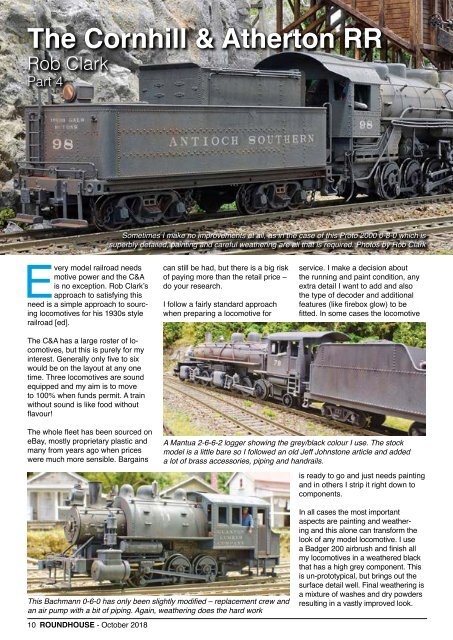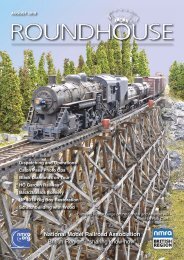NMRA RH October 2018
Create successful ePaper yourself
Turn your PDF publications into a flip-book with our unique Google optimized e-Paper software.
The Cornhill & Atherton RR<br />
Rob Clark<br />
Part 4<br />
Sometimes I make no improvements at all, as in the case of this Proto 2000 0-8-0 which is<br />
superbly detailed, painting and careful weathering are all that is required. Photos by Rob Clark<br />
Every model railroad needs<br />
motive power and the C&A<br />
is no exception. Rob Clark’s<br />
approach to satisfying this<br />
need is a simple approach to sourcing<br />
locomotives for his 1930s style<br />
railroad [ed].<br />
The C&A has a large roster of locomotives,<br />
but this is purely for my<br />
interest. Generally only five to six<br />
would be on the layout at any one<br />
time. Three locomotives are sound<br />
equipped and my aim is to move<br />
to 100% when funds permit. A train<br />
without sound is like food without<br />
flavour!<br />
can still be had, but there is a big risk<br />
of paying more than the retail price –<br />
do your research.<br />
I follow a fairly standard approach<br />
when preparing a locomotive for<br />
service. I make a decision about<br />
the running and paint condition, any<br />
extra detail I want to add and also<br />
the type of decoder and additional<br />
features (like firebox glow) to be<br />
fitted. In some cases the locomotive<br />
The whole fleet has been sourced on<br />
eBay, mostly proprietary plastic and<br />
many from years ago when prices<br />
were much more sensible. Bargains<br />
A Mantua 2-6-6-2 logger showing the grey/black colour I use. The stock<br />
model is a little bare so I followed an old Jeff Johnstone article and added<br />
a lot of brass accessories, piping and handrails.<br />
is ready to go and just needs painting<br />
and in others I strip it right down to<br />
components.<br />
This Bachmann 0-6-0 has only been slightly modified – replacement crew and<br />
an air pump with a bit of piping. Again, weathering does the hard work<br />
10 ROUNDHOUSE - <strong>October</strong> <strong>2018</strong><br />
In all cases the most important<br />
aspects are painting and weathering<br />
and this alone can transform the<br />
look of any model locomotive. I use<br />
a Badger 200 airbrush and finish all<br />
my locomotives in a weathered black<br />
that has a high grey component. This<br />
is un-prototypical, but brings out the<br />
surface detail well. Final weathering is<br />
a mixture of washes and dry powders<br />
resulting in a vastly improved look.



